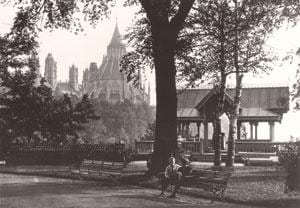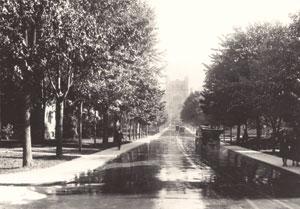
Two men on a bench, Major's Hill Park, early 1900s. Credit: City of Ottawa Archives
For many years now, I have been doing research for a book on the history of men who had sex with men in Ontario cities in the years between 1880 and 1940. The primary source I have used is criminal court records. In the early part of the 20th century, all sexual relations between men were illegal, whether they were in public or private, no matter what the ages of the parties involved. As a result, many men were arrested and prosecuted in court. The transcripts of their trials can tell us much about the social circumstances of men who engaged in homosexual activity in the past.
Before diving into the tales of desire and danger, a couple caveats. First, although I will occasionally refer in a descriptive way to “homosexual subcultures” or “homosexual activity,” it’s better to think of the men involved as “men who had sex with other men” rather than as gay or homosexual. Most of the men during this period did not adopt a gay or homosexual identity. Those identities would become popular only later in the century, and we should avoid projecting onto men in the past our present-day categories and labels.
Second, while the men who turned up in the court records were diverse in terms of their class and their ethnic and sometimes racial backgrounds, the fact remains they were all men. This has something to do with the sources. Sexual activity between women, for example, was not criminalized during this period in the same way it was for men, and so similar kinds of sources do not exist for women. However, I hope the example of my research will encourage others to dig into different types of sources to uncover lesbian, transgender and other sexually dissident histories.
The court records suggest that Ottawa’s subculture shared many of the same features of other North American urban homosexual undergrounds, such as the way men used public spaces like parks and lavatories to find other men. But the capital city’s subculture also had distinct characteristics. Its shape reflected Ottawa’s social-economic structure and particularly, its urban geography. Ottawa, then as now, was made up of several distinct neighbourhoods, each of which left its mark on men who searched for sex with other men. To demonstrate how this worked, let’s begin by looking at Centretown.
In the opening decades of the 20th century, Ottawa’s industrial base began to decline, replaced by the rapid growth of the civil service. In a corresponding transformation, Ottawa’s commercial centre shifted from Lowertown to Sparks and Wellington streets. Many people, particularly young, white, English-speaking men deemed the most promotable by the civil service, filled the white-collar jobs found in the area’s many government offices.
Salaries earned from such employment allowed people (again, many more men than women) to move out from under the watchful eyes of family and lead independent lives. Housing developers built apartment buildings to cater to those who desired single rather than family residences. An Ottawa city directory of 1916 lists more than 200 apartment houses, concentrated mostly in Centretown. Indeed, Centretown emerged as the principal residential district for anglo professionals and public servants.
With his earnings, a young man could rent an apartment in Centretown. While this may seem relatively mundane to many of us, having one’s own place in the early 20th century was something of a luxury. For those men who could afford it, having an apartment provided privacy and a place to bring men home.
In 1917, Charles F, a clerk in the federal Customs Department, lived at 74 O’Connor St, in a building known as the Edenburgh Apartments. The city directory reveals that all of the other 12 apartments in the building were occupied by men. In February of that year Charles received a call from the lobby of his apartment house informing him that there was a delivery boy with a parcel. Charles let Romeo O, a 15-year-old French-Canadian lad who worked for Hewitt’s Messenger Service, come up to his apartment. Charles invited Romeo to come in and, according to Romeo’s court testimony, “He asked me if I wanted to see some nice pictures. He showed me the four photographs and after I had looked at them he said that will make you horny.”
Charles’s seduction failed, as Romeo was not interested. In fact, Romeo returned to work and told his boss about the encounter. That same evening Charles was visited by an Ottawa police constable and arrested for attempting to indecently assault another male person.
Some men pooled their resources to rent a Centretown home. In 1916, another man named Charles lived at 176 Metcalfe St in a house that he shared with two other men. In August of 1916, Charles P met a young man named James B on the street. Their encounter was typical of the many casual meetings struck up by men on city streets. As Charles told the court, “I saw James B on the corner of Elgin and Nepean. I asked him for a match. He then asked about my singing. He said he could play the piano. He asked me if he could go to my room to play the piano and sing. I permitted him to come.”
James explained to the court what happened next: Charles “asked me to go into bed with him. I went into bed. He felt me all over with his hands. He took my penis in his mouth and sucked me off.” Arrested on a charge of gross indecency, Charles asserted his professional identity and respectability, telling the court, “I am a civil servant. I have been in Ottawa for 10 years.”
For civil servants, the importance of work and wages, as well as of domestic and neighbourhood arrangements, extended beyond the ways it permitted men to establish single, independent lives. Occupational ties forged between men in the civil service could be an important resource for a man when he found himself in trouble. During Charles F’s court appearance, two friends — another clerk in the Customs Department and a surveyor employed by the federal government — both testified as to Charles’s reputation for morality. The judge found Charles not guilty.
It is clear reading the case files that men in the civil service were able to draw on their relatively high status as a way of defending themselves in court when caught in sexual encounters, often with young working-class men. Lacking the status of their middle-class sexual partners, working-class men tended not to fare as well in court. The case against Charles P was dismissed by the judge, while James was found guilty of having stolen a fancy pin from Charles. In my next article, we will look more closely at the homosexual underground of Ottawa’s working-class and immigrant districts.

 Why you can trust Xtra
Why you can trust Xtra


